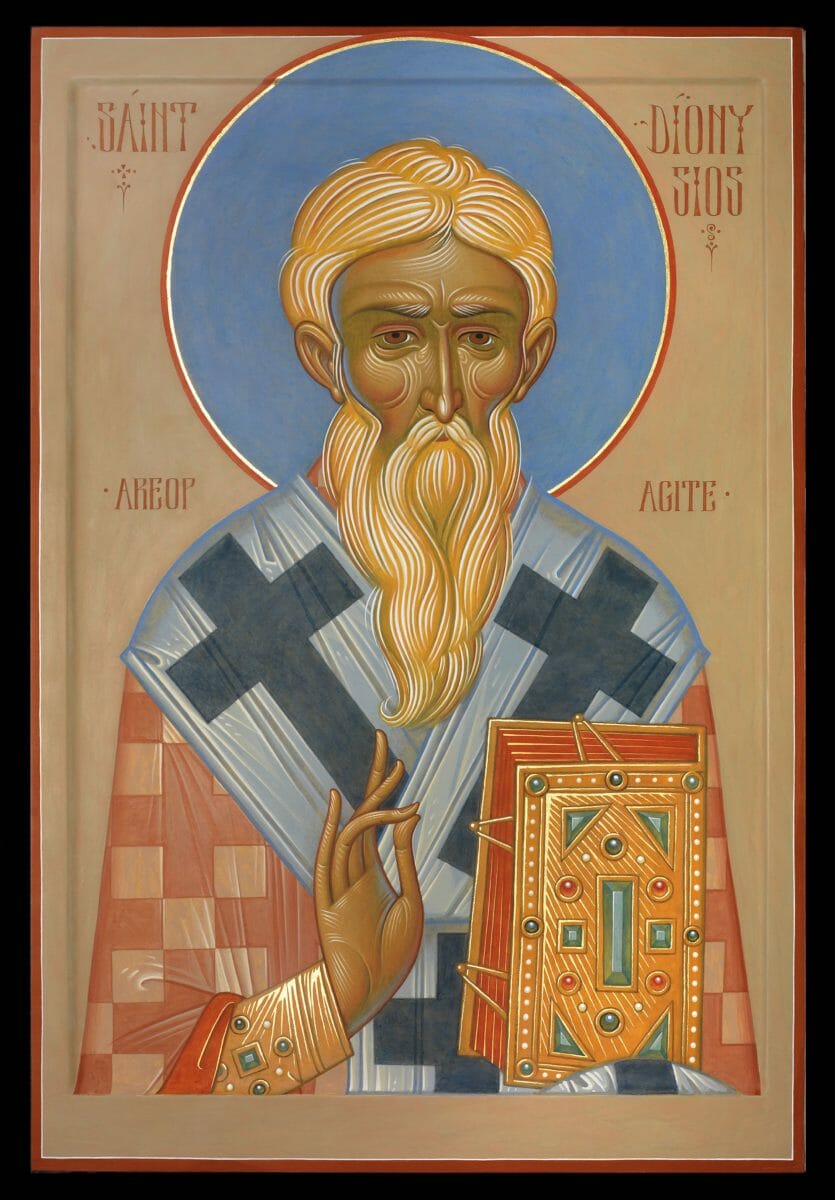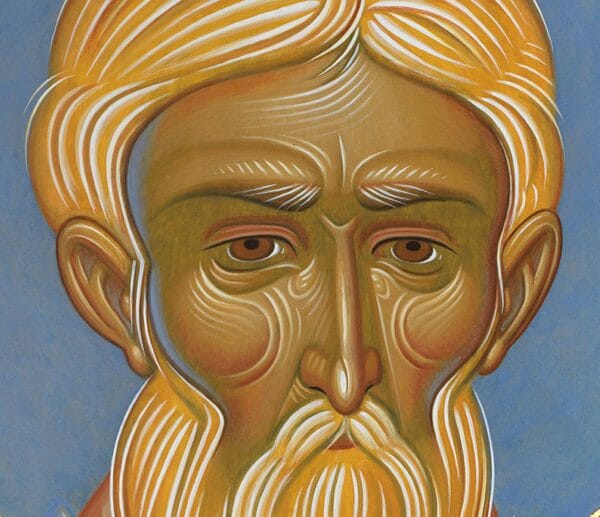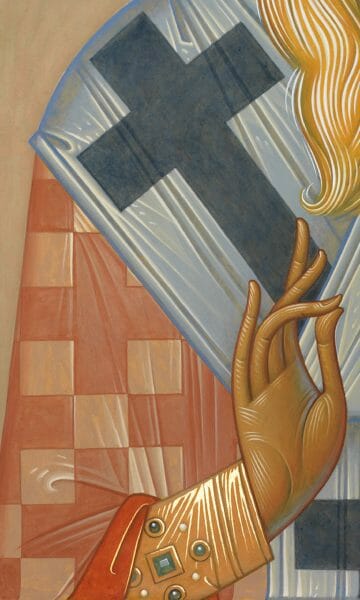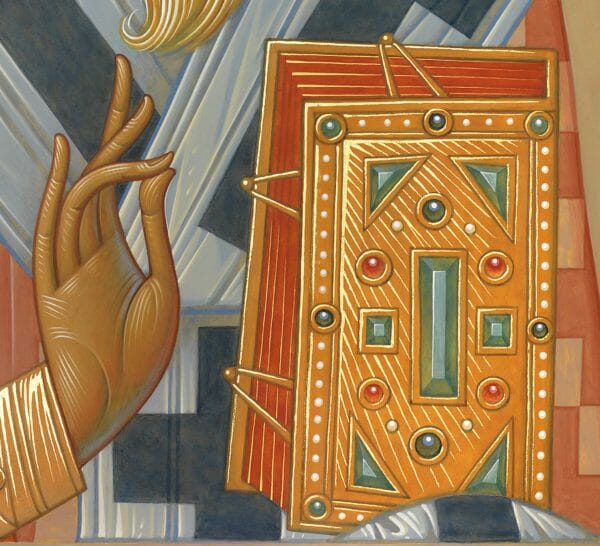Similar Posts

St. Dionysios the Areopagite, by Fr. Silouan Justiniano, 2019. Egg tempera and gold on wood panel, 15 x 22 1/2 in.
…Timothy, my friend, my advice to you as you look for a sight of the mysterious things, is to leave behind you everything perceived and understood, everything perceptible and understandable, all that is not and all that is, and, with your understanding laid aside, to strive upward as much as you can towards union with him who is beyond all being and knowledge.
St. Dionysios the Areopagite, The Mystical Theology[i]
In this new icon, St. Dionysios the Areopagite seems to gently smile as he firmly blesses the viewer. With his blue halo, he seems to be shining “in the brilliant darkness of a hidden silence.”[ii] But why, some might ask, does St. Dionysios have an unusual blue halo?
Let us just pause for a moment, lift up our eyes and see how, “The heavens declare the glory of God” (Ps. 19:1). It’s not surprising, therefore, that the beauty of the azure firmament has for millennia been seen as a symbol of the mystery of the Infinite, the Eternal, of Heaven itself. Blue, as the “glory of God,” represents the Uncreated Light radiating out from the “divine darkness”. The terrestrial manifests the celestial, the temporal the eternal. And since St. Dionysios, the unerring beholder of divine mysteries, is perhaps the most eloquent expositor of apophatic theology, as seen in his Mystical Theology, he bears a blue halo, designating his illumination and knowledge of ineffable realities experienced within the “divine darkness”. Moreover, in the Celestial Hierarchy St Dionysios speaks of blue as a “sign of hiddenness”.[iii] Blue has been also associated with the cherubim, as designating their power in divine knowledge or contemplation.[iv] Furthermore, in the Philokalia, blue is described as the color of the purified nous: “When the intellect [nous] has shed its fallen state and acquired the state of grace, then, during prayer, it will see its own nature like a sapphire or the color of heaven. In Scripture this is called the realm of God that was seen by the elders on Mount Sinai.”[v] And in Exodus we read, “Then Moses went up with Aaron, Nadab and Abihu, and seventy of the elders of Israel, and they saw the God of Israel; and under His feet there appeared to be a pavement of sapphire, as clear as the sky itself…” (Exod. 24: 9-10). Hence the blue halo in the icon of our monastery’s patron speaks of seeing beyond vision; knowing union beyond knowledge; of entering into the presence of the One who is beyond being.
As we can see, we’re not limited to symbolically depicting the Uncreated Light by the use of gold, red, green, or, for that matter, any other color. All colors, after all, are the perception of specific wavelengths of light – pure light made perceptible to the eye. The unseen made sensible. A reminder of how the Formless has taken on form; how the Light of the world has become flesh. Another example of how phenomenal reality is nothing other than a symbol, the Uncreated manifesting and making itself accessible through the kaleidoscope of nature. So, the color blue is only one among many other pictorial means through which the icon painter can convey what ultimately transcends sense perception and conception.
Notes:
*This article is dedicated to the memory of the author and poet Hugo Ball.
[i] St. Dionysios the Areopagite, “The Mystical Theology,” in Pseudo Dionysios the Areopagite: Complete Works, C. Luibheid (trans.), Paulist Press, NY, 1987, p.135.
[ii] Ibid.
[iii] Op. cit., p.189.
[iv] A Dictionary of Christian Antiquities, ed. Sir William Smith and Samuel Cheetham. London, 1893, p.87.
[v] Evagrios Pontikos, “Texts on Discrimination in respect of Passions and Thoughts,” in: The Philokalia: The Complete Text, St. Nikodimos of the Holy Mountain and St. Makarios of Corinth (ed.),G.E. E. Palmer, Philip Sherrard, Kallistos Ware (trans.), Vol. I, London, Farber and Farber, 1981, p. 49.




It’s good to see an article authored by you again, Fr Silouan. Thank you for such an informative & thought-provoking piece.
I appreciate your willingness to step outside conventional use of color and its referential meanings, dear Father. But I do think “seems to gently smile” is a bit of a stretch. 😉
Lol…Yes, maybe you’re right. What I meant was that there is something gentle about his gaze and demeanor in general. Thanks for being candid as usual. I always appreciate your comments, Baker.
I think I can see the smile. The slight angle of his mouth and the puckered cheeks suggest that he might be smiling under his beard. But he could just as easily be stern. He reminds me of some monks I’ve met, who seem to be always correcting people and laughing joyfully all at once.
This a magnificent and important icon, Fr. Silouan. Your unusual use of colors in his face really makes him seem saturated with light that is not quite of this world. This is a great example of painterly technique to represent visual truth that is beyond normal perception.
I’m impressed how his posture and form so accurately represent a frail old man, and that this is readable through all the thick clothing he’s wearing. It really seems like a painting of a specific actual person of great character and grace, and not just another instance of ‘bearded monk typology’. It leaves me feeling like I now know the man. An amazing accomplishment.
Thank you Andrew. I’m glad to see that I wasn’t just imagining things. You very effectively capture with words the subtleties of the icon. Yes, I think it is crucial for the icon painter to aim to capture the saint as a “specific actual person”. We should sense his living presence.